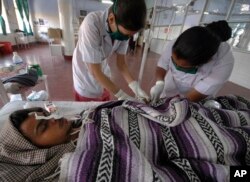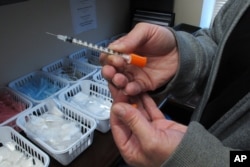The United Nations' World Health Organization says millions of lives could be saved if people infected with viral hepatitis were tested and treated for these potentially fatal diseases.
New WHO data from the just released Hepatitis 2017 report show an estimated 325 million people globally are living with chronic hepatitis B or hepatitis C virus infections.
WHO said hundreds of thousands of people infected with these diseases are dying because they lack access to life-saving testing and treatment. The agency noted that most people are untested and do not even know that they are infected.
Consequently, WHO said they remain untreated and are at risk of “a slow progression to chronic liver disease, cancer and death.”
Hepatitis B virus is transmitted between people through contact with blood or other body fluids. Hepatitis C virus is spread through direct contact with infected blood.
Latest estimates show that viral hepatitis caused 1.34 million deaths in 2015 and that some 1.75 million people were newly infected with hepatitis C, bringing the total number of people living with this disease globally to 71 million.
Comparable to TB
Gottfried Hirnschall, director of WHOs department of HIV/global hepatitis program, said that the number of deaths from viral hepatitis was comparable to that of tuberculosis.
However, he noted that hepatitis kills more people than HIV, the virus that causes AIDS, and significantly more than malaria.
“What is, however, the difference between hepatitis and those three other diseases is that the trend for hepatitis is upwards. We are seeing an increase in mortality while for the other three diseases, it has been going down over the years," Hirnschall said. "Since 2000 and 2015, we have seen a 22 percent increase from one million, as I said, to 1.34 million.”
Hirnschall said there was a range of interventions and tools, including highly effective vaccines and medicines that can prevent hepatitis from becoming a chronic and fatal disease.
WHO estimates 257 million people worldwide were living with chronic hepatitis B in 2015. However, it noted that new infections have been falling dramatically thanks to increased coverage of HBV vaccination among children.
Hepatitis B is mainly transmitted in the first years of life from mother to child and is most prevalent in the Western Pacific and African regions.
While this safe and effective vaccine has been around since 1982, nations have been slow to use it. But Ana Maria Henao Restrepo, team leader of the department of immunization, vaccines and biologicals, observed that this has changed.
She said 95 percent or 185 countries now use the hepatitis B vaccine in routine immunization programs.
“That is great and as I mentioned because of this, 85 percent of the infants worldwide are protected with three doses of hepatitis B vaccine. Where we are lagging behind is on the first dose that is given after birth. It is very important to prevent infections from the mother,” she said.
Restrepo said only 50 percent of countries were delivering this vaccine. Without this vaccine, she said “people become chronically infected and require medication and diagnosis” throughout their lifetime.
Unsafe injections
Unsafe injections in health care settings and injecting drug use are the most common modes of hepatitis C transmission. The problem is most widespread in the Eastern Mediterranean and European regions.
While using clean needles and syringes will prevent transmission of the disease, Gottfried Hirnschall said there is a highly effective drug that can cure hepatitis C within a relatively short time.
“A person needs to take a single tablet or a tablet every day for two to three months and most of the people will be cured.”
He said few people have availed themselves of this treatment for a long time because of the exorbitantly high $84,000 price tag.
“They were very high to start with. They are still very high in many countries, particularly in high-income countries,” he said.
“But, as the report also points out, the price of these treatments has come down considerably. It costs as little as $200 in some countries now, per cure for treatments, which is quite striking.”
Charles Gore, President of the World Hepatitis Alliance said WHO's Global Hepatitis Report provides an understanding of the true impact of the disease, providing “new data and a set of very specific, global and regional targets to reach by 2030.
“For instance, global deaths from hepatitis must be brought down from 1.34 million to lower than 469,000 people per year," he said.
Hirnschall said the new possibilities of cure for hepatitis C and the possible elimination of hepatitis B through vaccination have created some positive momentum and greater public attention on these heretofore “silent epidemics.”
“The momentum has clearly been driven by the excitement around some new opportunities we do now have,” he said.






